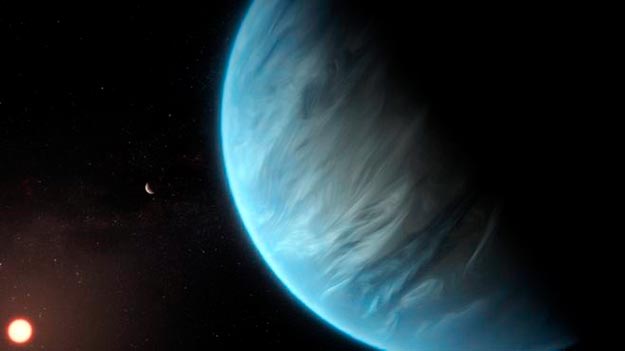In the atmosphere of an exoplanet just 111 light-years away, astronomers have just made a highly exciting discovery: they’ve detected water.
As much as 50 percent of the atmosphere of K2-18b could be water vapour. But unlike other giant exoplanets on which atmospheric water has been detected, K2-18b is a super-Earth. It could be rocky, like Earth, Mars and Venus.
Not only could this discovery help us to understand the atmospheres of habitable zone exoplanets in general, but those of habitable zone rocky exoplanets in close orbit around red dwarf stars.
“Finding water in a potentially habitable world other than Earth is incredibly exciting,” said astronomer Angelos Tsiaras of University College London.
“K2-18b is not ‘Earth 2.0’ as it is significantly heavier and has a different atmospheric composition. However, it brings us closer to answering the fundamental question: Is the Earth unique?”
K2-18b was discovered in 2015, and it’s been a bit of a tricky exoplanet to pin down. We know that it orbits a red dwarf star named K2-18 pretty closely, completing the circle once every 33 days. Additionally, the planet’s stellar irradiation levels are similar to Earth’s (except for the high flare activity typical of red dwarfs).
That’s because this 33-day orbit is right smack-bang in the middle of the star’s habitable zone – not too hot that liquid water would evaporate from the surface, and not so cold that it would totally freeze.
We also know that the planet is about twice the size of Earth, and about eight times the mass. Astronomers even narrowed the planet down to two possible types. In 2017, a team determined that it could either be a rocky planet with an atmosphere – like Earth, but bigger – or a planet with a mostly water interior, covered in a thick shell of ice, like Enceladus or Europa.
The new research suggests that K2-18b has an atmosphere after all.
The planet was detected by Kepler (RIP), which detected planets via the transit method. This is when the star system is aligned just right for the planet to pass between us and its star – called a transit – causing a detectable dimming of the star’s light.
This transit can also help us study a planet’s atmosphere. When the star’s light passes through, some wavelengths can be absorbed by specific gases, producing lines on a spectrum. These can be picked out when you compare a spectral profile of the star against a spectral profile of the transit.
But it’s not easy. Even detecting the planet in the first place requires highly sensitive instruments capable of detecting the faint dips in starlight; the spectral absorption lines are also incredibly faint.
Tsiaras and his team did it using the WFC3 instrument on the Hubble Space Telescope. They imaged eight transits of the planet in front of the star, and combined them to produce a weighted average, creating a spectral profile for the planet.
Next, it was time to find out what that spectral profile was telling them, using modelling. Initially, they ran K2-18b atmosphere models with a range of atmospheric molecules that could produce absorption lines, including water (H2O), carbon monoxide (CO), carbon dioxide (CO2), methane (CH4), and ammonia (NH3).
In the planet’s spectrum, only water could be detected with any confidence, so the team revised their analysis, using only water as a trace gas.
They then modelled the atmosphere using three different approaches: cloudless, with water vapour in a hydrogen-helium atmosphere; cloudless, with water vapour, hydrogen-helium and molecular nitrogen; and cloudy, with water vapour and hydrogen-helium.
All three simulations produced a statistically significant atmosphere at high confidence levels, with values so similar they couldn’t quite distinguish the three potential types.
It was not possible, based on the current information, to constrain the abundance of water; but the models suggested that between 20 and 50 percent of the planet’s atmosphere could be water vapour. For reference, Earth’s atmosphere varies between 0 and 5 percent water vapour (or 0.25 percent on overall average by mass). So K2-18b would be a pretty humid place.
Nor can the presence of methane and ammonia be ruled out, since their wavelengths aren’t covered by the WFC3.
All this makes a pretty compelling case for pointing the next generation of wider wavelength instruments – such as the James Webb Space Telescope and the Atmospheric Remote-sensing Infrared Exoplanet Large – in the planet’s direction.
“Although the subject of habitability for temperate planets around late-type stars is a subject of active discussion, and real progress requires substantially improved observational constraints,” the researchers write in their paper, “the analysis presented here provides the first direct observation of a molecular signature from a habitable-zone exoplanet, connecting these theoretical studies to observations.”
Source: https://www.sciencealert.com/
Dear User/Visitor! Please, answer on our questions: tick off one of the positions – your answer will make us able to improve our site and make it more interesting and useful!


